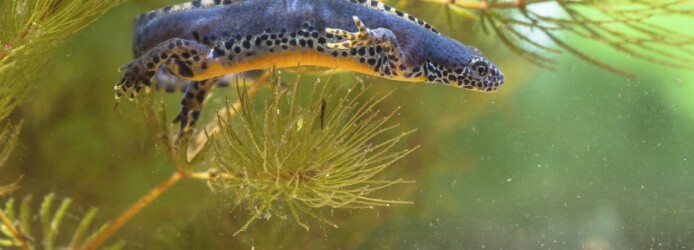Newts choose their own water bodies. For them to settle in the garden pond, it must be as close to nature as possible.
Contents
How newts live
Domestic newts, which include thread, crested, mountain and pond newts, lead a hidden life. Especially during their stay on land from August to March they are rarely seen. Then the animals live in damp places near bodies of water. For those who want to settle these shy amphibians, this time is the best opportunity to attract them to their own garden pond.
In late fall, newts burrow deep into the ground to go into hibernation. This is how they survive the winter period. When temperatures rise in spring, they awaken from their hibernation and the breeding season begins. To do this, the males of great crested and pond newts grow a dorsal crest that makes them look bizarrely like a small dragon.
To attract females, the males emit scents and wag them at the female with their tails. By dancing around the mate, the male causes her to follow him, depositing a packet of seed. The female picks this up with her cloaca and begins laying eggs soon after. The larvae develop in the water for three months into small newts that come ashore in late summer.
Making the garden pond suitable for newts
If you want to settle newts in your garden pond, you have to design it close to nature. With luck, the newts will come on their own if they find a habitat where they feel comfortable. Since all newt species live both on land and in water, there must be a shallow shore zone. This allows them to easily get in and out of the pond.
They also need opportunities to hide. Hollowed out rocks, small logs, and branches that the owner places along the edge of the pond as well as in the pond are especially good. Equally important are underwater plants such as hornwort and waterweed, on which the female can spawn. Therefore, chlorine or algae cleaners should be avoided, as amphibians do not tolerate these agents.
The environment around the garden pond must also be natural. If there are plants at the edge of the pond, they should not be fertilized nor should a weed killer be used. Likewise, it is not advisable to mow the lawn during their stay on land in order to protect the newts from predators. Second, there is a risk of injuring them by mowing or drawing them into the mower.
Successfully establish tailed newts
Many pond owners do not know that fish should not swim in the garden pond if they want to establish newts in it. Especially species like goldfish and sticklebacks disturb the females during spawning and eat the spawn as well as the newt tadpoles. On the other hand, toads and frogs are no threat to the newt offspring. In addition, all newt species love tranquility, which is why a fountain or pond pump is not recommended.
Although newts are protected by law, it is not forbidden to introduce them into your own garden pond. Only from the wild the garden owner is not allowed to take them. But if he creates the appropriate living conditions, the amphibians may come on their own. If, again, this is not the case, native species should be bought from the newt breeder.
But whoever owns newts has to make sure that their habitat is preserved. Everyone must be aware that newts choose their own homes. They will only stay in a pond if they like it.


